During the novel coronavirus outbreak, one key realization has come to light: Local communities need to work together to combat the spread of the virus by encouraging social distancing and supporting vulnerable members and even local businesses. Cities and local government agencies can play a vital role by consistently creating and sharing reliable community-facing information, and taking immediate action around the issues that concern residents. Concurrently, social media has become one of the primary sources to which residents turn for the latest news, meaning government leaders can reach practically their entire community base online (even the less “tech-savvy”).
Therefore, in championing their communities through this crisis, local governments must understand their residents’ online behavior. What are the proven best channels for cities to reach them on? How do local governments effectively cut through the noise? And more.
To help answer these questions, the Zencity team analyzed over 86 million social media data points from the past 4 months (December 2019 – March 2020), from over 75 cities and counties, across 18 US states.
Here is what we found:
1. Social distancing has residents turning to social media and discourse has skyrocketed.
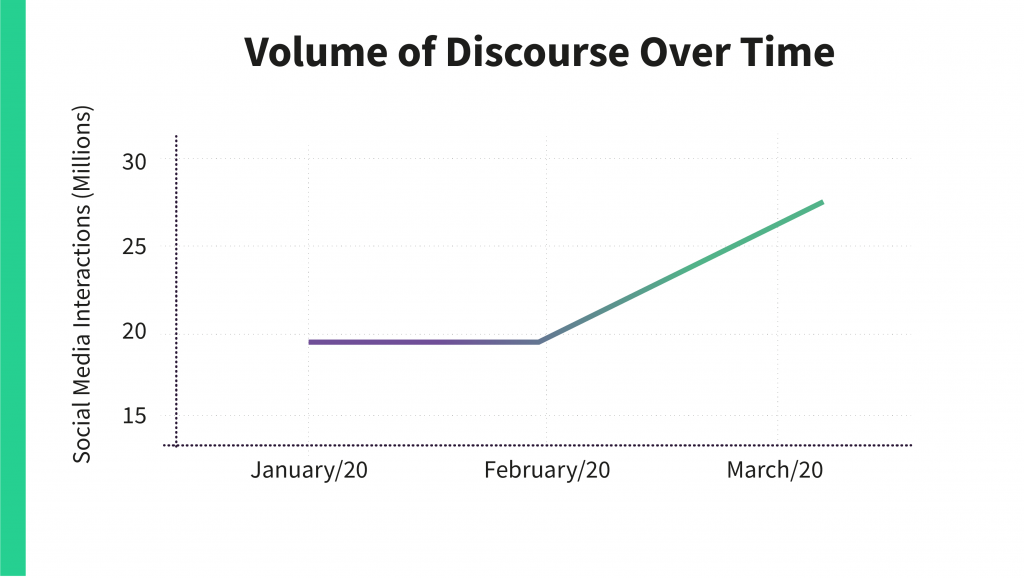
With new movement restrictions and residents being urged to practice physical social distancing, the COVID-19 outbreak has further amplified social media as an essential communication channel with and about one’s city. In other words, the town square has officially become digital.
A data-based comparison between social media activity during the COVID-19 crisis and prior months reflects the significant rise in resident’s engagement with the city. While the average volume of social media discourse in the cities analyzed was almost 20 million interactions across January and February, March’s online discourse soared to nearly 27M interactions. This 35% increase shows that residents are using digital channels more than ever to find relevant information and to raise their concerns and share thoughts and ideas. Now more than ever, cities can reach the majority of their community, with real-time updates and misinformation corrections.
2. Among city-owned channels, mayors’ accounts experienced the largest volume increase.
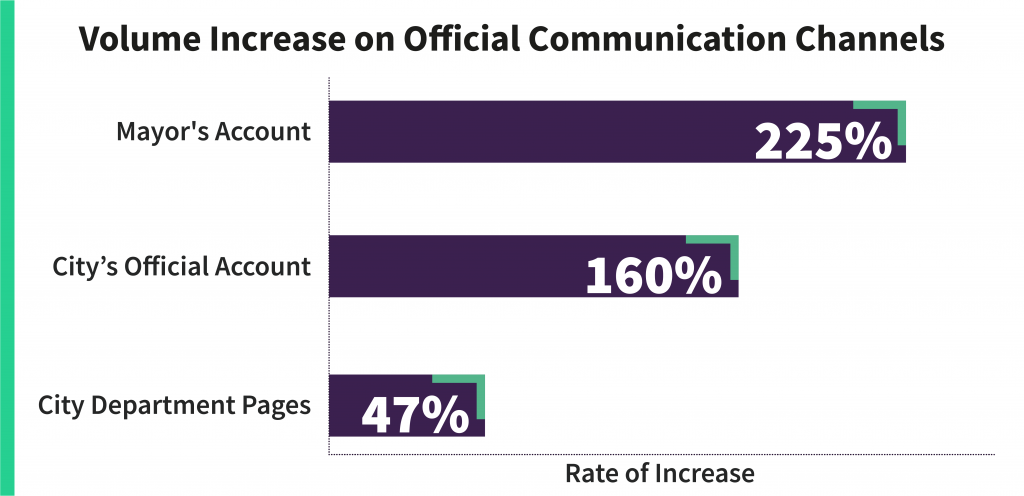
From our analysis of March 2020, we saw that all types of city-owned channels, from department-focused pages to mayors’ accounts, saw an increase in public discourse volume. Since the beginning of March, the volume of discourse on mayors’ official accounts increased by 225% and by 160% on cities’ official pages. Comparatively, conversations on news outlets and independent tweets increased by only 25%.
These numbers exemplify the significance of the mayor’s role in COVID-19 communication efforts. That means that local governments need to make use of their elected official’s account(s) to share relevant, reliable information. Also, even more importantly, mayors must be aware of their community’s real concerns and address them in their messaging and action – because the people are listening.
3. Residents consume most of their COVID-19 information from non-city owned channels.
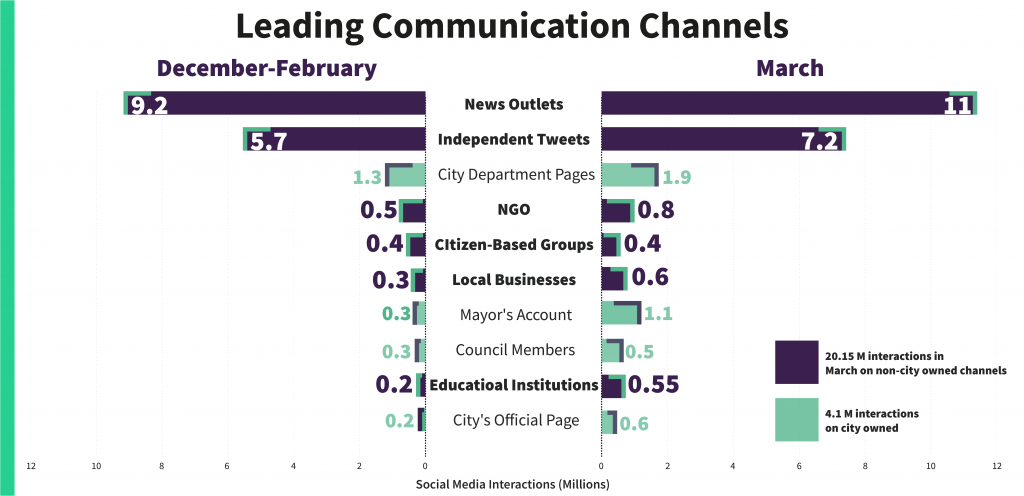
Even though we saw an increase in activity across city-owned channels, we still see that residents get most of their information and interact significantly more with non-city-owned channels. In particular, news outlets remain the primary source of information, followed by tweets and posts by independent individuals. In total, we tracked approximately 20.15 M interactions on non-city owned channels about COVID-19. In juxtaposition, we tracked only 4.1 M interactions on city-owned channels.
Considering this data and the rise in misinformation and disinformation across non-city owned channels, cities and local government agencies need to actively track discourse on these channels to get the full picture of what their community is talking about when it comes to COVID-19. Looking just at city-owned accounts will create a skewed view of communities’ needs. Without an ability to easily monitor these channels in real-time, it can be challenging to pinpoint residents’ needs and manage rumors, especially during this unprecedented pandemic.
4. Residents are actively engaging with their city’s communications through shares, comments and likes.
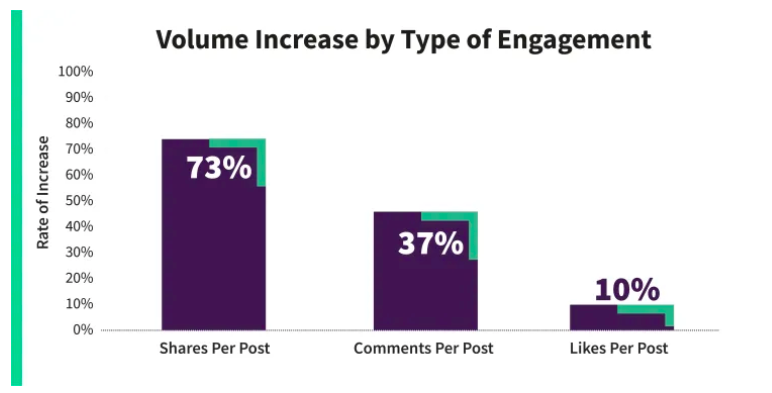
In conjunction with a 49% increase in the number of posts published by city-owned channels, we see a boost in residents’ engagement (reactions, comments, shares) with these posts. In particular, during the COVID-19 outbreak, we noted a 73% increase in the number of shares per post, and a 37% rise in the number of comments. Residents appear to find true value in the information provided by their city. Many residents are also taking an active part in disseminating these updates by actively “sharing” this information with their community and close social circles.
Notably, residents are not only engaging more with the cities’ posts, but they are also actively reaching out to the city. This is indicated by an increase in the number of tags and mentions of city channels and officials by residents – 2.2 times more during the COVID-19 crisis than average.
Looking at this data, a clear takeaway is that cities have to be stronger than ever on their messaging. They also need to have the ability to easily track, manage and understand what’s going on across all channels to respond to all different inquiries.
In Summary
Our analysis of the 80+ million social media interactions from the past 4 months proves that residents are looking to their city’s leaders as trusted and authoritative sources of information. We hope this study helps the men and women in local government leadership and communication roles better plan and craft their actions and messaging.
Check out our latest report on residents’ key concerns for the week of March 25th to the 31st.

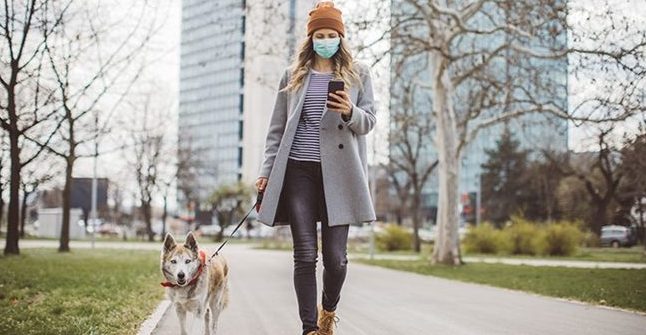


Leave a Reply
You must be logged in to post a comment.